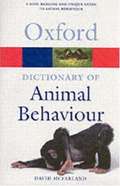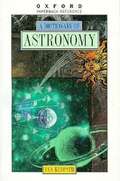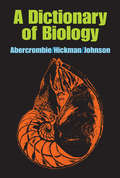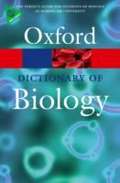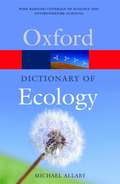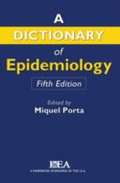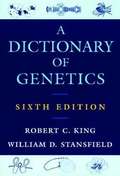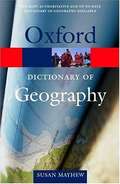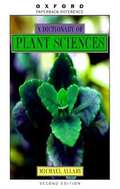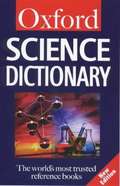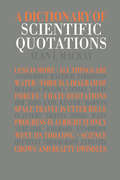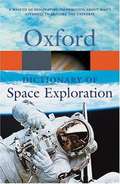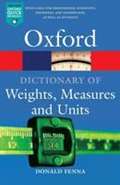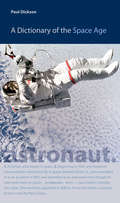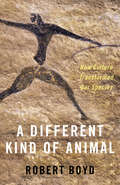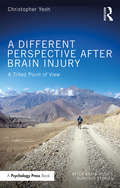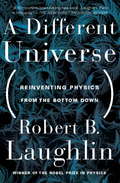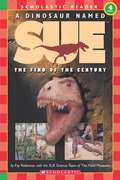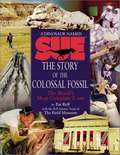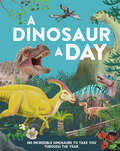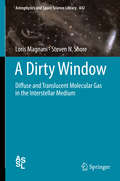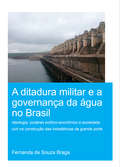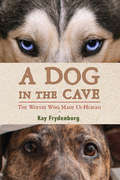- Table View
- List View
A Dictionary of Animal Behaviour
by David McfarlandThis dictionary covers every aspect of animal behaviour, from aggression to courtship, animal welfare to cognition. It is essential reference for students of the biological sciences and psychology, professionals, and the general reader with an interest in natural history and zoology. Features: a unique reference guide to the subject; multi-disciplinary - covers terms from the related fields of ecology, physiology and psychology; entries backed up by specific examples of behaviour in the animal kingdom; and includes an index of common and Latin animal names.
A Dictionary of Astronomy
by Ian RidpathAstronomy is expanding almost as rapidly as the universe itself, and the proliferating scientific jargon can sometimes baffle even the most dedicated amateur. Now, in some 4,000 concise, up-to-date entries, this dictionary cuts a clear path through the maze of complex technical language, offering full, clear definitions drawn from all aspects of astronomy. Compiled by Ian Ridpath, a fellow of the Royal Astronomical Society, and an expert team of contributors, A Dictionary of Astronomy contains the most recent entries from astrophysics and cosmology to galaxies and time. Here are succinct definitions for the Big Bang theory, comets, eclipses, Magellanic Clouds, Mars, quasar, relativity, and variable stars. Entries on telescopes and other measuring devices, observatories, space missions, and recently named Solar System objects show how astronomers have explored the universe. The Dictionary also provides biographical entries on eminent astronomers from Copernicus to Edwin Hubble. From black hole to white dwarf, and from spiral galaxies to solar waves, A Dictionary of Astronomy opens a window on the universe for amateur astronomers everywhere.
A Dictionary of Biology
by M. Abercrombie C.J. Hickman M.L Johnson"A Dictionary of Biology" is an up-to-date reference work explains several thousand specialized words that allow for empirical approaches to the biological sciences. It includes more than bare definitions, including information about most of the things named so as to convey their significance in biological discussion. M. Abercrombie, C. J. Hickman, and M. L. Johnson in effect interpret this language as it is actually used, emphasizing customary usage rather than etymology.This comprehensive lexicon includes two thousand entries. Many unfamiliar terms, especially the rarer ones, are defined with the help of other technical terms, perhaps equally unfamiliar. This trick of dictionary-makers could only be avoided by giving a complete account of a large part of biology under each heading. Every biological technical term used in a definition is itself defined elsewhere in the dictionary; though some semi-technical terms, words that can be found in any English dictionary are omitted.The authors use codes throughout the dictionary to help the reader to interpret the use of a word such as whether it is used in relation to plants and animals only, whether the word is an adjective, and when a term is defined elsewhere and adds information to the current definition. The result is an invaluable guide for the layman, the student, and the scholar alike. It presents clear and authoritative explanations of the terms and will remain useful as a quick and concise source of reference.
A Dictionary of Biology
by Elizabeth Martin Robert S. HineFully revised and updated for the sixth edition, this market-leading dictionary is the perfect guide for anyone studying biology, either at school or university. With over 5,200 clear and concise entries, over 300 of them new to this edition, it provides comprehensive coverage of biology, biophysics, and biochemistry. Features include biographical entries on key scientists and highlighted entries on important topics such as bioinformatics, genomics, molecular evolution, and protein structure, with further reading suggestions. Appendices include classification of the animal and plant kingdoms; geological timescale; major mass extinctions of species; model organisms and their genomes; and Nobel prizewinners - the last two new to this edition.
A Dictionary of Ecology (3rd edition)
by Michael Allaby"This dictionary contains over 5,200 entries on all aspects of ecology and related disciplines. Ideal for students of biology, ecology, environmental science, conservation studies, and the general reader with an interest in the natural world and a concern about its future." "The text includes: entries on biogeography, genetics, soil science, geomorphology, atmospheric science, and oceanography; Internet links to aid further research; and over 30 new illustrations and over 200 new entries."--BOOK JACKET.
A Dictionary of Epidemiology (Fifth Edition)
by Miquel Porta John M. Last Sander GreenlandThe new, completely revised, and updated edition of this classic text -- sponsored by the International Epidemiological Association (IEA) and previously edited by John Last -- remains the definitive dictionary in epidemiology worldwide. In fact, with contributions from over 220 epidemiologists and other users of epidemiology from around the globe, it is more than a dictionary: it includes explanations and comments on both core epidemiological terms and on other scientific terms relevant to all professionals in clinical medicine and public health, as well as to professionals in the other health, life, and social sciences. Anyone seeking clarity on epidemiological and methodological definitions important to human health will find it here.
A Dictionary of Genetics (7th edition)
by Robert C. King William D. Stansfield Pamela K. MulliganIn addition to such words and acronyms as </nucleomorph, OMIM, chromosome walking, floral identity,/> and </zygotic lethal/>, included are nongenetic terms frequently encountered in genetics literature such as </Hoogsteen base pairs, LINEs,/> and </undersea vent community/>. A strong feature is inclusion of genera and species of plants and animals important to genetics, which are cross-listed to an appendix that shows them nestled in their taxonomic habitat. Other appendices provide the scientific names of common domesticated plants and animals, a chronology of discoveries (1590-2001), a list of genome sizes and gene numbers, and two appendices listing periodical and website sources. The 6,580 definitions do not contain pronunciation or derivation. Annotation c. Book News, Inc., Portland, OR (booknews.com)
A Dictionary of Geography
by Susan MayhewThis unique new dictionary offers comprehensive coverage of words and terms encountered in both human and physical geography in a single volume. Each of the over 6,000 updated, clear, and concise entries provides an initial brief definition followed by a more in-depth explanation, making the book useful for novices and experts alike. This new edition also features a fact-finder with key economic and population statistics. Authoritative and completely accessible, A Dictionary of Geography, Second Edition covers a vast scope of subjects, including cartography, surveying, meteorology, climatology, biogeography, ecology, geology, geomorphology, population, migration, agriculture, industry, transportation, and development. There is also extensive discussion of the most recent advances in and information on topics such as plate tectonics, remote sensing, geographic information systems, and aerial differentiation. Wide-ranging and highly readable, this invaluable reference guide answers questions about all aspects,of geography quickly and effectively using the most recent advances in the field.
A Dictionary of Plant Sciences
by Michael AllabyThis is the most comprehensive and up-to-date paperback dictionary of botany available. Fully revised for this new edition, with over 5500 clear and concise entries, it will be invaluable to students, amateur botanists and naturalists, and everyone with an interest in plants and their environments. Wide coverage including biochemistry, plant physiology, cytology, ecology, genetics, evolution, biogeography, Earth history, and the Earth sciences. World-wide coverage of taxonomic groups - one-third of the entries are devoted to taxa, from bacteria and fungi to the main groups of flowering and non-flowering plants. Many new entries added from the field of molecular biology.
A Dictionary of Science (4th edition)
by Elizabeth Martin Alan Isaacs John DaintithNow in its fourth edition, this bestselling dictionary contains 9,000 entries on all aspects of science. Ideal for both students and non-scientists, it provides comprehensive coverage of biology (including human biology), chemistry, physics, the earth sciences, and astronomy. Short biographies of leading scientists Full-page illustrated features on such subjects as El Nino, the Solar System, and Genetically Modified Organisms Chronologies of specific scientific subjects including plastics, electronics, and cell biology 'The book will appeal not just to scientists and science students but also to the interested lay person. And it passes the most difficult test of any dictionary--it is well worth browsing through.' New Scientist 'All entries are clear and brief, written in no-nonsense prose A handy reference work.' TES 'Handy and readable for scientists aged nine to ninety' Nature
A Dictionary of Scientific Quotations
by Alan L. MackayScience affects us all-in the words of Albert Einstein, "The whole of science is nothing more than a refinement of everyday thinking." It is therefore fascinating to discover the thoughts of scientists, philosophers, humanists, poets, theologians, politicians, and other miscellaneous mortals on this most important of subjects. A Dictionary of Scientific Quotations is a personal selection of scientific quotations by Professor Alan L Mackay that includes graffiti, lines of song, proverbs, and poetry. Whether you believe that "All problems are finally scientific problems" (George Bernard Shaw) or that "Imagination is more important than knowledge" (Einstein), it is without doubt that "It is a good thing for an uneducated man to read books of quotations" (Churchill). You will be charmed and delighted by this collection and remember, "'Why,'" said the Dodo, "'the best way to explain it is to do it'" (Alice in Wonderland, Lewis Carroll).
A Dictionary of Space Exploration
by E. Julius DaschThis fascinating dictionary covers the exciting world of space exploration and every aspect of the technology involved. Containing over 2,500 entries it defines the jargon used in space exploration including such weird and wonderful terms as 'cherry picker' and 'burp firing'. All the entries are fully cross-referenced for ease of use, and important entries, such as the entry on the Apollo project, are presented as detailed feature articles. In addition to the main entries and definitions, the book also contains links to over 250 space-related websites, and a comprehensive chronology of space exploration. The entries are supported by over 50 photographs, illustrations and diagrams. Written by a team of experts, the entries have been edited by Dr E. Julius Dasch, former manager of the NASA National Space Grant Program. This authoritative, comprehensive and readable dictionary is essential reading for anyone with an interest in astronomy and space travel.
A Dictionary of Weights, Measures, and Units
by Donald FennaThis comprehensive and authoritative dictionary provides clear definitions of units, prefixes, and styles of weights and measures within the Systeme International (SI), as well as traditional, and industry-specific units. It also includes general historical and scientific background, covering the development of the sequential definitions and sizing of units. This new reference work will prove invaluable to professional scientists, engineers, technicians as well as to students and the general user. Over 1,600 clear and concise entries complete with historical background. Covers a broad range of disciplines, including astronomy, electromagnetics, geology, photography, mathematics, meteorology, physics, and temperature. Notes on associated terminology. Numerous tables, including the geochronologic scale and the equation of time. Comprehensive coverage of the whole Systeme International.
A Dictionary of the Space Age (New Series in NASA History)
by Paul Dickson2009 Outstanding Academic Title, ChoiceThe launch of Sputnik 1 in 1957 ushered in an exciting era of scientific and technological advancement. As television news anchors, radio hosts, and journalists reported the happenings of the American and the Soviet space programs to millions of captivated citizens, words that belonged to the worlds of science, aviation, and science fiction suddenly became part of the colloquial language. What’s more, NASA used a litany of acronyms in much of its official correspondence in an effort to transmit as much information in as little time as possible. To translate this peculiar vocabulary, Paul Dickson has compiled the curious lingo and mystifying acronyms of NASA in an accessible dictionary of the names, words, and phrases of the Space Age.Aviators, fighter pilots, and test pilots coined the phrases "spam in a can" (how astronauts felt prelaunch as they sat in a tiny capsule atop a rocket booster); "tickety-boo" (things are fine), and "the Eagle has landed" (Neil Armstrong’s famous quote when Apollo 11 landed on the Moon).This dictionary captures a broader foundation for language of the Space Age based on the historic principles employed by the Oxford English Dictionary and Webster’s New Third International Dictionary. Word histories for major terms are detailed in a conversational tone, and technical terms are deciphered for the interested student and lay reader. This is a must-own reference for space history buffs.
A Different Kind of Animal: How Culture Transformed Our Species
by Robert BoydHow our ability to learn from each other has been the essential ingredient to our remarkable success as a speciesHuman beings are a very different kind of animal. We have evolved to become the most dominant species on Earth. We have a larger geographical range and process more energy than any other creature alive. This astonishing transformation is usually explained in terms of cognitive ability—people are just smarter than all the rest. But in this compelling book, Robert Boyd argues that culture—our ability to learn from each other—has been the essential ingredient of our remarkable success.A Different Kind of Animal demonstrates that while people are smart, we are not nearly smart enough to have solved the vast array of problems that confronted our species as it spread across the globe. Over the past two million years, culture has evolved to enable human populations to accumulate superb local adaptations that no individual could ever have invented on their own. It has also made possible the evolution of social norms that allow humans to make common cause with large groups of unrelated individuals, a kind of society not seen anywhere else in nature. This unique combination of cultural adaptation and large-scale cooperation has transformed our species and assured our survival—making us the different kind of animal we are today.Based on the Tanner Lectures delivered at Princeton University, A Different Kind of Animal features challenging responses by biologist H. Allen Orr, philosopher Kim Sterelny, economist Paul Seabright, and evolutionary anthropologist Ruth Mace, as well as an introduction by Stephen Macedo.
A Different Perspective After Brain Injury: A Tilted Point of View (After Brain Injury: Survivor Stories)
by Christopher YeohWhilst preparing for his travel adventures into a world he had yet to explore, Christopher Yeoh was involved in a road traffic accident and experienced something few others would be "privileged" to witness. Eight days in a coma, more than a year in and out of hospital and a gradual re-introduction to the world of work. A Different Perspective After Brain Injury: A Tilted Point of View is written entirely by the survivor, providing an unusually introspective and critical personal account of life following a serious blow to the head. It charts the initial insult, early rehabilitation, development of understanding, the return of emotion, moments of triumph and regression into depression, the exercise of reframing how a brain injury is perceived and a return to work. It also describes the mental adjustments of awareness and acceptance alongside the physical recovery process. Readily accessible to the general public, this book will also be of particular interest to professionals involved in the care of people who have had significant brain injuries, brain injury survivors, their families and friends and also those who fund and organise health and social care. This unique author account will provide a degree of understanding of what living with a hidden disability is really like.
A Different Universe: Reinventing Physics From the Bottom Down
by Laughlin Robert B.In this age of superstring theories and Big Bang cosmology, we're used to thinking of the unknown as impossibly distant from our everyday lives. But in A Different Universe, Nobel Laureate Robert Laughlin argues that the scientific frontier is right under our fingers. Instead of looking for ultimate theories, Laughlin considers the world of emergent properties-meaning the properties, such as the hardness and shape of a crystal, that result from the organization of large numbers of atoms. Laughlin shows us how the most fundamental laws of physics are in fact emergent. A Different Universe is a truly mind-bending book that shows us why everything we think about fundamental physical laws needs to change.
A Digital Signal Processor for Particle Detectors: Design, Verification and Testing (Springer Theses)
by Arild VelureTo cope with the new running conditions in the ALICE experiment at the Large Hadron Collider at CERN, a new integrated circuit named SAMPA has been created that can process 32 analogue channels, convert them to digital, perform filtering and compression, and transmit the data on high speed links to the data acquisition system. The main purpose of this work is to specify, design, test and verify the digital signal processing part of the SAMPA device to accommodate the requirements of the detectors involved. Innovative solutions have been employed to reduce the bandwidth required by the detectors, as well as adaptations to ease data handling later in the processing chain. The new SAMPA device was built to replace two existing circuits, in addition to reducing the current consumption, and doubling the amount of processing channels. About 50000 of the devices will be installed in the Time Projection Chamber and Muon Chamber detectors in the ALICE experiment.
A Dinosaur Named Sue: The Find of the Century
by Fay RobinsonFound in the Badlands of South Dakota in 1990, "Sue" the dinosaur is the largest and most complete T-Rex fossil ever discovered. Young readers can learn about her amazing story, from the beginning to the exciting restoration work leading up to her spring 2000 debut.
A Dinosaur Named Sue: The World's Most Complete T. Rex
by Patricia RelfRelf and the SUE Science Team of The Field Museum track the story of largest and most complete T. rex fossil ever found, beginning with its discovery in 1990 in South Dakota, and leading up to its unveiling at the Field Museum in Chicago in 2000.
A Dinosaur a Day: 365 Incredible Dinosaurs to Take You Through the Year
by Miranda SmithDiscover a new dinosaur for every day of the year! The perfect gift for dinosaur fans ages 6 and up.New day, new dino! Immerse yourself in this unforgettable year-long encounter with the most astonishing creatures ever to walk the Earth.In this gorgeous calendarized collection, you&’ll find familiar and lesser-known names—from ferocious Tyrannosaurus to armored Ankylosaurus—alongside newly discovered species, all brought to life with stunning illustrations and fascinating facts.Prepare to encounter some familiar reptilian faces, as well as learn about new-to-you dinosaurs that might become new favorites. With 365 dinosaurs to take you through the year, this is the quintessential introduction to all things dinosaur.It's the ultimate gift for any dino lover, from age 6 to 106!
A Dirty Window: Diffuse and Translucent Molecular Gas in the Interstellar Medium (Astrophysics and Space Science Library #442)
by Loris Magnani Steven N. ShoreThis book provides an introduction to the physics of interstellar gas in the Galaxy. It deals with the diffuse interstellar medium which supplies a complex environment for exploring the neutral gas content of a galaxy like the Milky Way and the techniques necessary for studying this non-stellar component. After an initial exposition of the phases of the interstellar medium and the role of gas in a spiral galaxy, the authors discuss the transition from atomic to molecular gas. They then consider basic radiative transfer and molecular spectroscopy with particular emphasis on the molecules useful for studying low-density molecular gas. Observational techniques for investigating the gas and the dust component of the diffuse interstellar medium throughout the electromagnetic spectrum are explored emphasizing results from the recent Herschel and Planck missions. A brief exposition on dust in the diffuse interstellar medium is followed by a discussion of molecular clouds in general and high-latitude molecular clouds in particular. Ways of calibrating CO observations with the molecular hydrogen content of a cloud are examined along with the dark molecular gas controversy. High-latitude molecular clouds are considered in detail as vehicles for applying the techniques developed in the book. Given the transient nature of diffuse and translucent molecular clouds, the role of turbulence in the origin and dynamics of these objects is examined in some detail. The book is targeted at graduate students or postdocs who are entering the field of interstellar medium studies.
A Ditadura Militar e a Governança da Água no Brasil: Ideologia, Poderes Político-Econômico e Sociedade Civil na Construção das Hidrelétricas de Grande Porte (The Role of Ideology, Political-Economic Power and Civil Society in the Construction of Large Hydropower Dams) (IHE Delft PhD Thesis Series)
by Fernanda de Souza BragaIn recent decades there has been an exponential increase in large hydroelectric plants in Brazil, especially in the Amazon region. These large hydraulic structures impact the environment and the lives of people living in the places where they settle and require a special type of water governance. The dictatorial regime (1964-1985) created a "standard" for the construction of these great structures, through an institutional and legal framework, which benefited the Brazilian business elite but also, through the creation of a popular imagination, which shows itself lasting progress on the country's progress and development. The suspension of security, the fragility of institutional environmental structures, the disrespect for indigenous reserves, the lack of clarity about the concept of "affected population" and the non-payment of fair compensation were identified as one of the main challenges for a democratic water governance in the country. In the late 1970s, the Dam-Affected Movement (MAB) began its organization and is also studied in this research. The study is an important and insightful academic contribution to the understanding of the main bottlenecks of effective water governance in Brazil.
A Diversity of Pathways Through Science Education
by Yew-Jin Lee Yann Shiou Ong Timothy Ter Ming TanThis book presents the work of academics who contributed their work at the International Science Education Conference (ISEC) 2021, in alignment with the conference theme '20/20 Vision for Science Education Research.' Collectively, the chapters aim to evoke intellectual dialogues on current and future trends in science education. It features chapters that are grouped thematically into three sections: Questions and Questioning in Science/STEM education, Developing Science Teaching and Assessment, and History, Philosophy, and Sociology of Science/Engineering, and Informal Learning. Through the various sections, the book presents empirical studies in science and engineering classrooms or laboratories, puts forward a framework for problem-based learning, provides an account of a prominent scientist’s efforts in promoting practical science through analysis of historical documents, and uncovers trends in informal science learning space research through a review of literature. Each section is introduced by a commentary with further insights and thought-provoking questions on ideas raised in the chapters. The book also includes a 'Notes to Our Future Colleagues' section in each chapter, which presents readers with a collective vision for the state of science education research in the year 2050.
A Dog in the Cave: The Wolves Who Made Us Human
by Kay FrydenborgWe know dogs are our best animal friends, but have you ever thought about what that might mean? Fossils show we’ve shared our work and homes with dogs for tens of thousands of years. Now there’s growing evidence that we influenced dogs’ evolution—and they, in turn, changed ours. Even more than our closest relatives, the apes, dogs are the species with whom we communicate best. Combining history, paleontology, biology, and cutting-edge medical science, Kay Frydenborg paints a picture of how two different species became deeply entwined—and how we coevolved into the species we are today.
